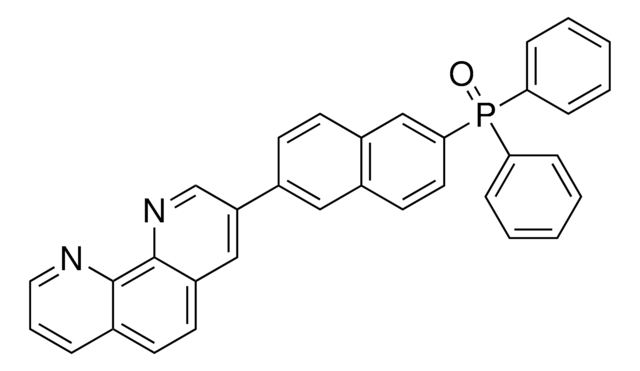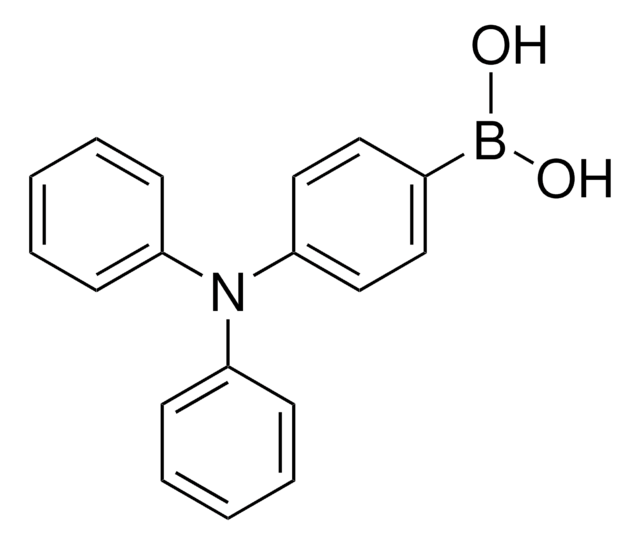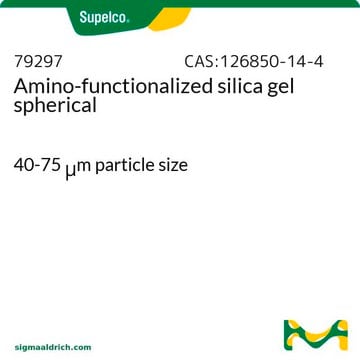906395
EH44
≥99% (HPLC)
Synonym(s):
9-(2-Ethylhexyl)-N,N,N,N-tetrakis(4-methoxyphenyl)- 9H-carbazole-2,7-diamine)
About This Item
Recommended Products
description
Band gap in film: 2.99eV, calculated from UV-vis
Band gap in solution: 3.00eV, calculated from UV-vis
Assay
≥99% (HPLC)
form
powder
solubility
insoluble (Methanol and Hexane)
soluble (DMSO, THF, Toluene, o-Xylene, Anisole, Chloroform, Chlorobenzene, and 1,2-Dichlorobenzene)
Orbital energy
HOMO - 4.85 eV
SMILES string
CCC(CCCC)CN1C2=CC(N(C3=CC=C(OC)C=C3)C4=CC=C(OC)C=C4)=CC=C2C5=CC=C(N(C6=CC=C(OC)C=C6)C7=CC=C(OC)C=C7)C=C15
General description
Application
Using EH44 as HTM in a device configuration of: SnO2/PAL/EH44/MoOx /Al, not only generated high power conversion efficiency (PCE) comparable to the record PCE by using the state-of-the-art-HTM Spiro-OMeTAD, but also most importantly showed greatly improved device stability: even under the combined stresses of light (including ultraviolet light), oxygen and moisture, perovskite solar cells using EH44 as hole transporting layer were shown to retain 94% of their peak efficiency despite 1,000 hours of continuous unencapsulated operation in ambient air conditions (relative humidity of 10-20%). When stability tests were conducted in an inert atmosphere, degradation of only ∼2% over the course of 1,500 hours of continuous operation was observed.
Note that in the above mentioned result, silver bis(trifluoromethanesulfonyl)imide (product 668001) was used to oxidize EH44 and yield EH44+TFSI−.EH44+TFSI− was then blended with neat EH44 at various ratios to control the conductivity (and optical transparency if desired) and optimize the device performance. The impressive power conversion efficiency (PCE) of 18.5% was achieved for a perovskite solar cell using EH44 layers of ∼60 nm thickness doped with 14wt% EH44+TFSI− and 25 mg/ml 4-tert-butylpyridine (product 142379), which is comparable to device performance using spiro-OMeTAD (19%) as the HTM.
Storage Class Code
11 - Combustible Solids
WGK
WGK 3
Flash Point(F)
Not applicable
Flash Point(C)
Not applicable
Certificates of Analysis (COA)
Search for Certificates of Analysis (COA) by entering the products Lot/Batch Number. Lot and Batch Numbers can be found on a product’s label following the words ‘Lot’ or ‘Batch’.
Already Own This Product?
Find documentation for the products that you have recently purchased in the Document Library.
Customers Also Viewed
Articles
Professor Chen (Nankai University, China) and his team explain the strategies behind their recent record-breaking organic solar cells, reaching a power conversion efficiency of 17.3%.
Our team of scientists has experience in all areas of research including Life Science, Material Science, Chemical Synthesis, Chromatography, Analytical and many others.
Contact Technical Service









